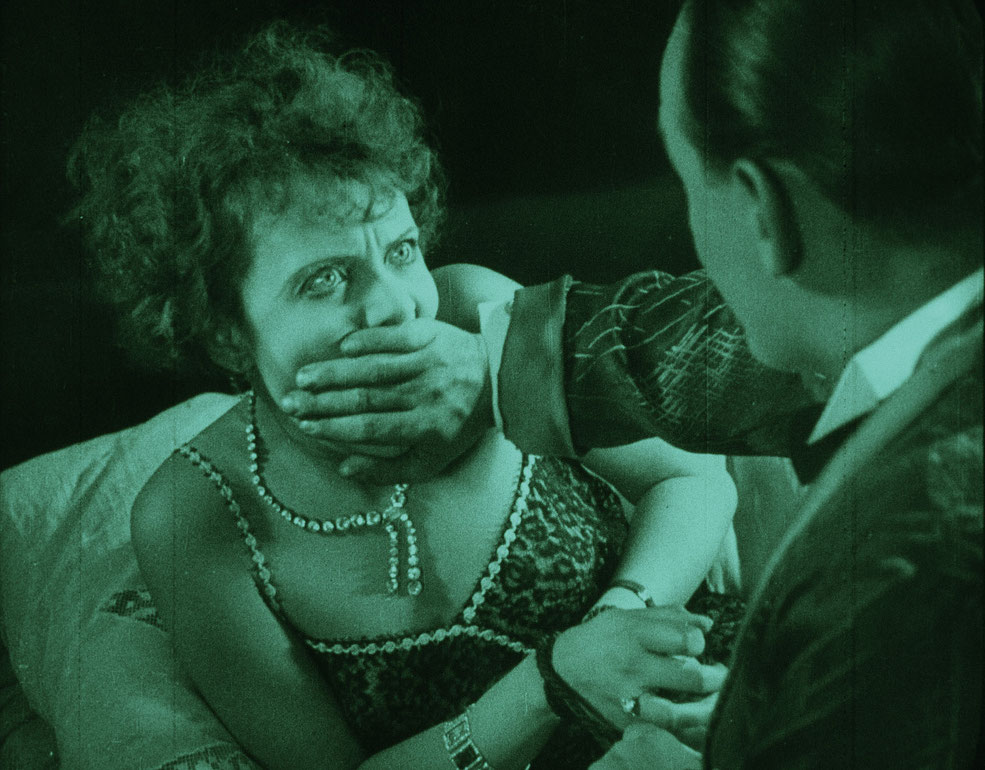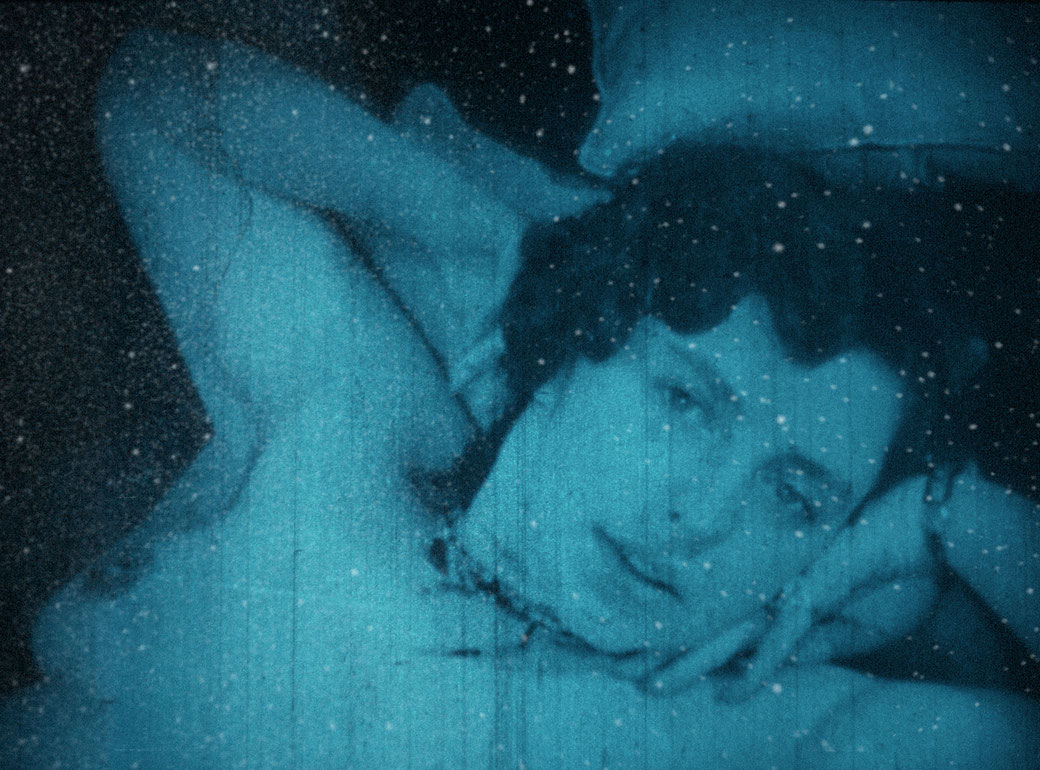FILM IST. a girl & a gun
Es war einmal die Geburt des Kinos aus dem Geiste des Jahrmarkts, der Taschenspielertricks und Feuerwerkereien (Genesis). Der tiefrot glühende, blühende Lichtspielplanet (Paradeisos) war bald von allerhand Menschlein in jubelnder Bewegung bevölkert, die hüpften, robbten, rollten grüppchenweise durch Wälder, über Dünen. Später öffnete der Mann der Frau seinen Wandsafe aufs Codewort "Eros"; ein kleiner Finger wurde zärtlich geküsst, brutaler Zugriff mit Bissen in die Hand erwidert. Das Zeitalter der Maskeraden, Versteckspiele, Verstellungen war angebrochen. Fremde Männerhände spannten, bogen Frauenkörper. Phallische Objekte brachten Lust und Tod (Thanatos). Nach der (Kopf-)Geburt des Kugelmenschen sah man Leiber lieber paarweise (Symposium).
"Wird fortgesetzt" heißt es am Ende. Unter Verwendung von Bildern "aus den ersten viereinhalb Jahrzehnten der Kinematografie", gefunden in elf internationalen Archiven, hat Gustav Deutsch diesmal ein musikalisches "Filmdrama in fünf Akten" gebaut. Im Kleinen orientiert sich die Montage von FILM IST. wieder an visuellen Analogien, an der äußeren Ähnlichkeit von Körpern, Objekten, Schauplätzen, Bewegungen und Erzählungen. Der Film konstruiert seine eigenen verblüffenden Attraktionen aus der Konfrontation von dokumentarischen, fiktionalen, pornografischen, wissenschaftlichen oder propagandistischen Bildern, die ihrem ursprünglichen Sinn und Zweck buchstäblich entfremdet sind. Bildern also, die nicht notwendigerweise zusammengehören, aber dafür Zusammenhänge sichtbar herstellen.
Den roten Faden liefern die antike Mythologie, fragmentarisch gehaltene Zitate von Hesiod, Sappho und Platon: Und von der Antike führt eine Linie auch zu jenen mythischen Erzählungen, die das Kino heute noch schreibt. FILM IST: a girl & a gun.
(Isabella Reicher)
FILM IST. a girl & a gun ist ein filmisches Drama in 5 Akten, über eines der ältesten Themen der Kinematographie und der Menschheit: die Konfrontation der Geschlechter. Von der Genesis des Universums und der Welt durch das Zusammenwirken aber auch durch die Konfrontation von Schöpfungsgöttinnen und -göttern, über das unschuldige Zusammenleben von Frauen und Männern im Zustand des Paradieses, über die Sehnsucht, die Verführung, die Liebe, die Eifersucht und den Hass der Geschlechter im Zeichen des Eros, zu der Eskalation in der gewaltsamen Unterwerfung und Ausbeutung der Geschlechter im Krieg und in der Pornografie im Spiegel des Thanatos, bis zu den Lösungen, die die Aufklärung, die Religion und die Politik anbietet, im Dialog des Symposions, wurden filmische Bilder aus den ersten viereinhalb Jahrzehnten der Kinematografie recherchiert, ausgewählt, und zu Bildfolgen und Bildgeschichten mit neuen Bedeutungsinhalten montiert.
(Gustav Deutsch)
In Old Clips, a Paradise Found and Lost (Kritik)
If the narrative that Mr. Deutsch has created is rather less thrilling than his mostly silent and often glorious images, this is nonetheless a story well worth considering, and watching. Using material gathered from the likes of the Imperial War Museum (in Britain) and the Kinsey Institute for Research in Sex, Gender and Reproduction (at Indiana University), he has fashioned something of an origin story about cinema itself. Its a tale that begins with an unidentified image of a woman in buckskin shooting at some targets and ends with a cowboy bandit pointing his gun at the camera, an image appropriated from Edwin S. Porters 1903 short, The Great Train Robbery, one of the most famous in cinema history. Tucked between these loaded images, as it were, is a vision of cinematic paradise, found and lost.
Tumult of a kind pursues the shooting woman (nothing new there) in the form of a mesmerizing, mysterious shot of what looks like an archery target in flames and some text (at the first Chaos came to be) from Theogony, an epic Greek poem by Hesiod about the origin of the world. The archery target gives way to fiery orange images of billowing smoke and some electronic thrumming. (The intermittent score tends to underscore the obvious.) The thrumming turns to droning, the smoke turns to lava, followed by more Hesiod (wide-bosomed earth), a woman with bountiful breasts, Paradeisos (Greek for paradise) and naked beachfront frolickers.
It is, as you might guess, all downhill from there, at least on one level. Cinematically, however, there are more delights to come. In addition to being an estimable archaeologist of the cinema, to borrow a nice description from the Austrian critic Stefan Grissemann, Mr. Deutsch is a crackerjack editor. In the next section, Eros, for instance, he intercuts images of a muscleman curling and uncurling his arms with time-lapse images of blooming flowers, underlining the sensuous similarities between the different motions. But because he is constructing a story, he then slips an image of a woman into the mix, which adds a suggestion of drama (whats she doing here?) to what had been an elegant visual comparison between man and flower.
Women turn out to be the fly in the ointment in a Girl & a Gun. (Dead flies cause the ointment of the apothecary to send forth a stinking savor or so it says in Ecclesiastes.) Among the many images that follow, many beautifully and floridly tinted, are sleeping, dreaming and fornicating clothed and unclothed women. In one early section, a woman drowsing in a steam room seems to dream of both an undulating jellyfish and a swimming man. In another section, a woman watches a man spin four strange dials hidden behind a cabinet, as if he were initiating her into a secret world. (On the soundtrack, you hear she dies.) A world, a subsequent shot suggests of a woman reading a newspaper with the headline Cine Monde that has been made from images.
A Girl & a Gun Film Ist is German for Film Is is the third in Mr. Deutschs evolving series that began with Film Ist. (1-6), which was created largely from scientific images, and continued with Film Ist. (7-12), stitched together from early cinema gags and tricks. (These will be shown at Anthology Film Archives in New York, in conjunction with the theatrical run of a Girl & a Gun.) Part of the pleasure of the first sections is their relative straightforwardness, particularly 1-6, which, through artfully edited visual splendors a talking skeleton, a walking cat, a spinning record creates a graceful meditation on cinema as motion, as material, as perfection. With a Girl & a Gun, Mr. Deutsch brings in Eros and Thanatos to a seductive if familiar end.
By MANOHLA DARGIS
Published: December 2, 2009, New York Times
Melissa Anderson / VILLAGE VOICE NY (Kritik)
Melissa Anderson / VILLAGE VOICE NY about FILM IS. a girl & a gun by Gustav Deutsch
FILM IST. a girl & a gun
2009
Österreich
93 min




